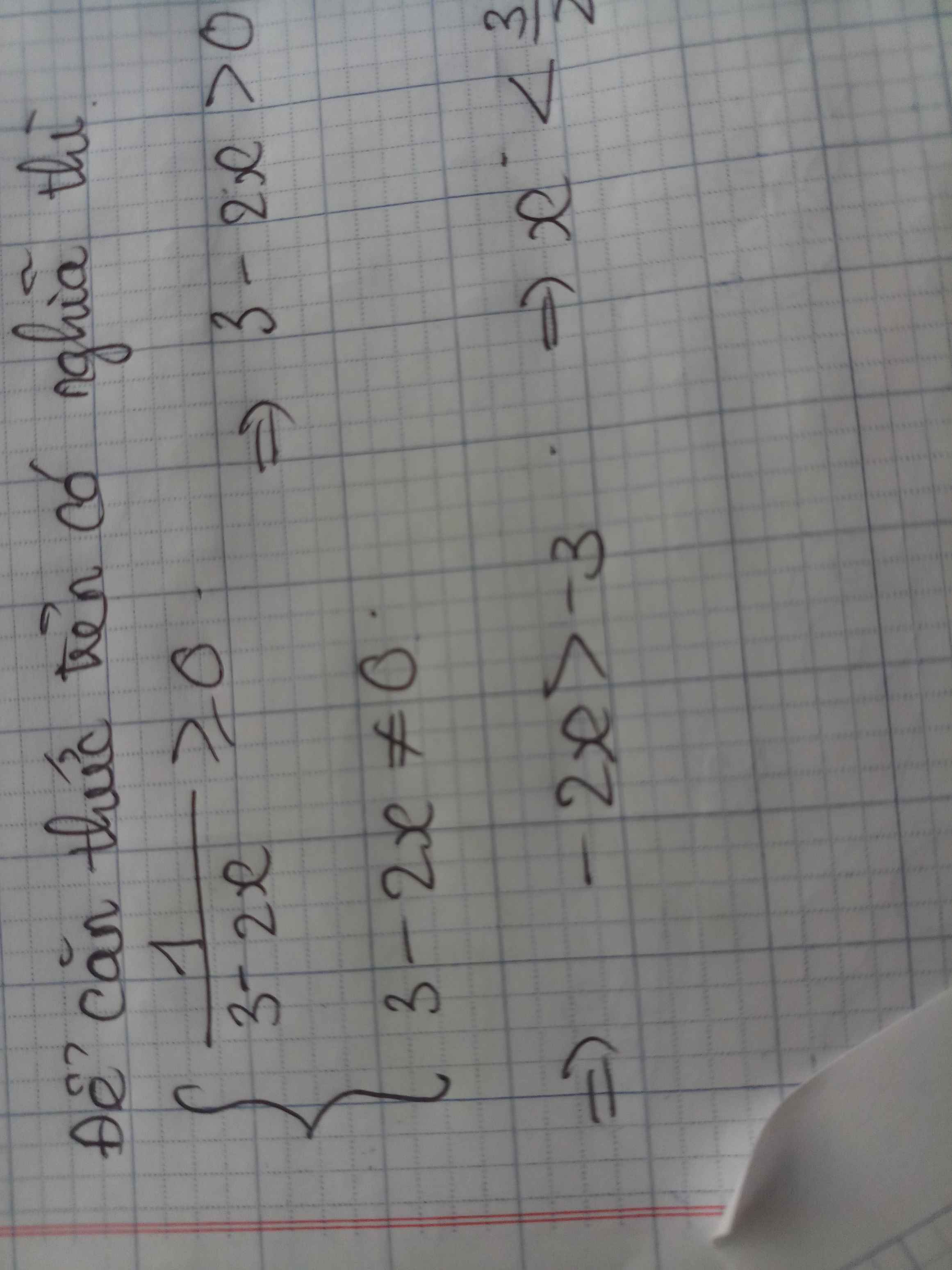Hãy nhập câu hỏi của bạn vào đây, nếu là tài khoản VIP, bạn sẽ được ưu tiên trả lời.

Vì `2>0` và `x^{2}>0` ( Với `x\ne0` )
`->(2)/(x^{2})>0`
Vậy với mọi giá trị của `x` thì căn thức đều có nghĩa ( `x\ne0` )

Để \(\sqrt{\dfrac{1}{3-2x}}\) có nghĩa
Khi\(\dfrac{1}{3-2x}\ge0\)
\(\Leftrightarrow3-2x>0\)
\(\Leftrightarrow-2x< -3\)
\(\Leftrightarrow x>\dfrac{3}{2}\)

Để \(\sqrt{\dfrac{2+x}{5-x}}\) có nghĩa
<=> \(\dfrac{2+x}{5-x}\ge0\)
<=> (2+x)(5-x) \(\ge0\) và 5-x\(\ne\)0
<=> \(\left[{}\begin{matrix}x\le-2\\x\ge5\end{matrix}\right.\) và x\(\ne\)5
<=> \(\left[{}\begin{matrix}x\le-2\\x>5\end{matrix}\right.\)
cái này bạn để ý có 2 mốc là -2 và 5, trái dấu thì trong khoảng, cùng dấu thì ngoài khoảng

` ĐK:(-5)/(x^{2}+6)>=0`
Vì `-5<0` và `x^{2}+6>0`
`->(-5)/(x^{2}+6)<0`
Vậy căn thức trên không tồn tại, không có giá trị của `x` thỏa mãn

Để căn thức có nghĩa thì:
\(\sqrt{\dfrac{1}{-1+x}}>0\) và \(-1+x\ne0\)
\(\Leftrightarrow x>1\)
\(ĐKXĐ\left\{{}\begin{matrix}\dfrac{1}{-1+x}\ge0\\-1+x\ne0\end{matrix}\right.\) ( Tử và mẫu cùng dấu )
Mà 1 > 0 \(\Rightarrow-1+x>0\)
\(\Leftrightarrow\) \(x>1\)

`ĐK:(x-1)/(x+2)>=0`
`TH1:`
`x-1>=0` và `x+2>0`
`<=>x>=1` và `x> -2`
`<=>x>=1`
`TH2:
`x-1\le0` và `x+2<0`
`<=>x\le1` và `x< -2`
`<=>x< -2`
Vậy `x>=1` hoặc `x< -2` thì căn thức có nghĩa
ĐKXĐ: \(\left[{}\begin{matrix}x\ge1\\x< -2\end{matrix}\right.\)

\(\dfrac{1}{\sqrt{x}+2}+\dfrac{\sqrt{x}}{\sqrt{x}-3}\) có nghĩa \(\Leftrightarrow\left[{}\begin{matrix}\sqrt{x}\ge0\\\sqrt{x}-3\ne0\end{matrix}\right.\)
\(\Leftrightarrow\left[{}\begin{matrix}x\ge0\\\sqrt{x}\ne3\end{matrix}\right.\)
\(\Leftrightarrow\left[{}\begin{matrix}x\ge0\\x\ne9\end{matrix}\right.\)

a, ĐK: \(x>0\)
\(\dfrac{x-5\sqrt{x}}{x+3\sqrt{x}}=\dfrac{\sqrt{x}\left(\sqrt{x}-5\right)}{\sqrt{x}\left(\sqrt{x}+3\right)}=\dfrac{\sqrt{x}-5}{\sqrt{x}+3}\)

r: ĐKXĐ: \(x\ge-2\)